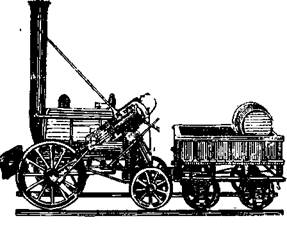home
 Economy Economy
 Books Books
 History of the world economy - Polyak GB History of the world economy - Polyak GB
|
History of the world economy - Polyak GB
20. Economic development of the leading countries of Europe in the era of the formation of industrial civilization (XIX century.)
XIX century. In the economic history of Europe was full of very important, fundamental events that radically changed the world economy. This was the period of completion of the bourgeois revolutions in France and Germany. The core of powerful states has been formed, which are still holding the leading positions in the world and, in many ways, even determine the destinies of the whole planet.
This was the period of the formation of an industrial civilization . A complex and multifaceted process of creating large-scale machine production in industry and other branches of the economy. Now in the total volume of production the leading positions belonged to the industry. An increasing proportion fell on the urban population. In the export of the leading countries, industrial output began to predominate, and in the import - agricultural products and raw materials. Labor productivity significantly increased. Growth rates of production have grown.
World science and technology were actively introduced into the world economy. Along with the wide use of steam engines, new engines were created-water and steam turbines, internal combustion engines. The grandiose railway construction covered and linked its network of economic spaces. There was an automobile industry. With the help of the ocean shipping company the continents were closely connected. The expansion of the communication message was facilitated by the invention of radio, telephone, telegraph. The real revolution was the development of the electric power industry, etc. The most important inventions were also implemented in military affairs. This smokeless gunpowder, long-range artillery, steam and diesel armored ships, etc.
XIX century. Did not bypass the socio-cultural sphere. As a result of bourgeois revolutions, the main classes of bourgeois society, the bourgeoisie and the proletariat , sometimes formed into acute social conflicts, were formed. The intelligentsia was forming. Significantly weakened the role of traditional religions. The emerging niche was filled by non-traditional ideologies and political parties. Modified forms of government. There were republics and constitutional monarchies. Acquired international relations were unprecedented. The colonial section of the world is over. There was a tough fight for its redistribution. The armed rivalry of the leading countries was accompanied by huge destruction and human losses.
In the 70-90's. XIX century. The accumulated colossal experience in the development of production resulted in a second scientific and technological revolution (the first - an industrial revolution). It, in turn, had a huge impact on the development of productive forces leading to the creation of new industries - metallurgy and machine building, transport and electric power, chemistry, etc. The heavy industry became predominant in industrial production.
20.1. Features of the socio-economic development of England
Consequences of industrial revolution
By the early 30's. XIX century. The industrial revolution in England was over. The large-scale machine production won a victory over the craft and the manufactory with their low labor productivity and manual equipment. Serious socio-economic changes took place in the country. By the middle of the XIX century. England turned into a country of cities and workers' settlements, where up to 86% of the population lived. The share of employed in industry and construction rose to 50%, while in agriculture it dropped to 15%. The triumph of free competition caused the desire to expand production. As a result, this led to a significant economic recovery of the country. And the strengthening of the technical base of production contributed to the transformation of England into a powerful industrial power - a "factory of peace, a workshop." Its share in the world was more than 40%.
The leader of industrial development remained the cotton industry. The number of factories equipped with weaving looms has grown. The release of cotton fabrics for 1800-1870 gg. Increased by 19 times, the consumption of cotton - more than 1000 times. In the middle of the XIX century. In the textile and clothing industry, over one-third of all workers were employed. Cheap and quality fabrics and products from them remained the main articles of English exports.
The heavy industry was gathering momentum. With the use of hot blast in the metallurgical process, the production of steel and cast iron increased significantly. More than 600 blast furnaces operated in the country mainly thanks to the new method of steel smelting, proposed by G. Bessemer in 1856. During 1800-1870, The output of coal increased (by 11 times) and the output of metal products (by 28 times). The share of England accounted for half of the production of pig iron, more than half of the world's hard coal. Output of heavy industry in the country exceeded four to five times the output of the US, Germany and France.
The successes of industrial development were largely due to the introduction of steam engines. Their capacity is only for the first half of the XIX century. Has grown more than 120 times, and by 1870 - 800 times. Steam engines have been successfully used in various sectors of the economy.

Tractor with steam engine for omnibus (1871)
To further accelerate the circulation of goods, expand and reduce the cost of economic ties between different regions of the country and overseas territories, the implementation of domestic and foreign trade was aimed at the development of steam transport. The island state of the country stimulated shipbuilding and shipping. Since 1811, steamship transport has developed in England, and construction of large ocean-going vessels began in the 1940s and 1950s.

Stephenson's "Rocket"
The invention in 1814 of the mechanic J. Stefenson locomotive and the construction in 1825 of the first railway stimulated further railway construction. A relatively small country covered by a network of railways, accelerated circulation of goods. If in 1840 the length of railways was 1.4 thousand km, then by 1870 it had grown almost 18 times and amounted to 25 thousand km.
The industrial revolution also had other significant consequences.
England from an agrarian country turned into a leading industrial power. The largest changes in the development of its productive forces, the equipping of production with more advanced and perfect equipment, contributed to a considerable increase in labor productivity-27 times over the period 1770-1840.
The growth of the social division of labor ensured the expansion of market relations. With the comparative narrowness of the domestic market, because of the low solvency of the working population, the struggle for foreign markets is the subject of special attention and concern. It establishes not only an industrial, but also a trade monopoly. England had a huge merchant fleet. During the 1800-1870's. Its tonnage increased more than 12.5 times and amounted to 60% of the world tonnage. England became the "world carrier".
Loss of world industrial leadership
However, in the last third of the XIX century. England gradually began to lose its leading position. The share of the country in world industrial production decreased from 32% in 1870 to 18% by the beginning of the 20th century. The rate of growth in industrial output fell. In the relative decay came the old industry - textile, metallurgy, coal. Their technical base, formed in the first half of the XIX century, had become obsolete. The production of new equipment was not established - electrical cut-off ivia tires and automatic looms, etc. Generally speaking, the English worker lagged considerably behind German, especially American, power-to-weight ratio.
In the 80-90's. The first English monopolies were formed. Large monopolistic associations were created in new branches of industry - electrical engineering, pipe-rolling, chemical, military, etc. Among them - the Anglo-German trust of explosives (Dynamite-Nobel, 1886), chemical trust (United Alcali, 1890). Morgan's financial group formed a powerful Anglo-American shipbuilding trust.
But the British monopolies, which were not particularly strong, were inferior to both German and American. The country's industry was largely export-oriented. A fabulous income from the exploitation of the colonies preserved the existing system of obtaining superprofits. The export of capital to the British bourgeoisie proved to be more profitable than its investment in the corresponding industry, into scientific and technical transformation and modernization of the economy. So, if in the last third of the XIX century. The national income of England has doubled, then the income from foreign investment - nine times.
In the old industrial branches (paper, carpet, glass, etc.) usually formed a few cartels as "trade associations". The cotton industry was characterized by the creation of separate monopoly associations for the decoration and coloring of fabrics.
Colonies
By the middle of the XIX century. Along with a powerful production and technical base, England began to possess huge colonial possessions. In fact, the country's power was largely ensured by the exploitation of the territories under its control. The robbery of the local population and the nonequivalent exchange, numerous tax levies, etc. flourished. The land and subsoil were subjected to ruthless ruin and plunder.
All the necessary raw materials and food arrived from the colonies at extremely low prices. In turn, the vast expanses of the British colonial empire served as a vast market for the highly profitable sale of British goods at monopoly prices.
At that time, the capture of India , the most beautiful pearl in the British crown, was completed. In India, about 70% of the population of the entire British Empire lived, by 1860 on an area of 6.5 million square meters. Km. Here lived 145 million people. True, the liberation movement that intensified in those years forced the British government to grant the status of the dominion to Canada, Australia, New Zealand, and the South African Union. These migrant colonies have become agrarian and raw materials appendages of the metropolis.
In the last third of the XIX century. The importance of the colonial empire for the British bourgeoisie has increased significantly. By the end of the XIX century. It has grown so much that more than 300 million people have already lived there. Colonization continued in the early XX century. To the former methods of enrichment at the expense of the colonies, the export of capital was added, which, because of the low costs of production on the ground, became very profitable.


Comments
Commenting on, remember that the content and tone of your message can hurt the feelings of real people, show respect and tolerance to your interlocutors even if you do not share their opinion, your behavior in the conditions of freedom of expression and anonymity provided by the Internet, changes Not only virtual, but also the real world. All comments are hidden from the index, spam is controlled.